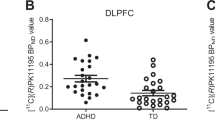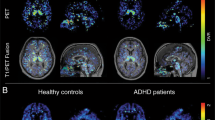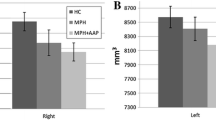Abstract
Attention-deficit/hyperactivity disorder (ADHD) is a neurodevelopmental disorder characterized by inattention, motor hyperactivity, impulsivity, and psychosocial as well as cognitive dysfunction. Although characteristic clinical manifestations have been described, no definitive biomarkers to diagnose ADHD have been established. In this review article, we summarize positron emission tomography (PET) studies conducted in adult patients with ADHD. We found that, although, disturbances of dopamine, serotonin, and norepinephrine functions have been implicated in ADHD, no characteristic findings have been identified from PET studies in patients with ADHD. Several previous PET studies on the central dopaminergic transmission-related ligands in patients with ADHD have shown altered binding of dopamine markers in the basal ganglia. However, no consistent results were observed in the binding characteristics for dopamine transporters and receptors. Findings from PET studies with ligands related to serotonin and norepinephrine pathways showed either unclear clinical significance or low replicability. Therefore, whether alterations of monoamine function may be involved in the pathophysiological mechanism remains to be clarified. The limitations of previous PET studies include their small sample sizes, focus on several kinds of existing ligands, and a questionable validity of the diagnosis (lack of biological diagnostic criteria). To determine the characteristic findings for diagnosing ADHD, further research is needed, and particularly, studies that evaluate new active ligands with specific binding to monoamine pathways should be undertaken.
Similar content being viewed by others
Data availability statement
Data sharing is not applicable to this article as no new data were created or analyzed in this study.
References
Posner J, Polanczyk GV, Sonuga-Barke E. Attention-deficit hyperactivity disorder. Lancet. 2020;395:450–62. https://doi.org/10.1016/S0140-6736(19)33004-1.
Polanczyk G, de Lima MS, Horta BL, Biederman J, Rohde LA. The worldwide prevalence of ADHD: a systematic review and metaregression analysis. Am J Psychiatry. 2007;164:942–8. https://doi.org/10.1176/ajp.2007.164.6.942.
Simon V, Czobor P, Bálint S, Mészáros A, Bitter I. Prevalence and correlates of adult attention-deficit hyperactivity disorder: meta-analysis. Br J Psychiatry. 2009;194:204–11. https://doi.org/10.1192/bjp.bp.107.048827.
Takahashi N, Ishizuka K, Inada T. Peripheral biomarkers of attention-deficit hyperactivity disorder: current status and future perspective. J Psychiatr Res. 2021;137:465–70. https://doi.org/10.1016/j.jpsychires.2021.03.012.
Nikolaus S, Mamlins E, Giesel FL, Schmitt D, Müller HW. Monoaminergic hypo- or hyperfunction in adolescent and adult attention-deficit hyperactivity disorder? Rev Neurosci. 2022;33:347–64. https://doi.org/10.1515/revneuro-2021-0083.
Spencer TJ, Adler LA, McGough JJ, Muniz R, Jiang H, Pestreich L, et al. Efficacy and safety of dexmethylphenidate extended-release capsules in adults with attention-deficit/hyperactivity disorder. Biol Psychiatry. 2007;61:1380–7. https://doi.org/10.1016/j.biopsych.2006.07.032.
Volkow ND, Ding YS, Fowler JS, Wang GJ, Logan J, Gatley JS, et al. Is methylphenidate like cocaine? Studies on their pharmacokinetics and distribution in the human brain. Arch Gen Psychiatry. 1995;52:456–63. https://doi.org/10.1001/archpsyc.1995.03950180042006.
Ding YS, Fowler JS, Volkow ND, Dewey SL, Wang GJ, Logan J, et al. Chiral drugs: comparison of the pharmacokinetics of [11C]d-threo and L-threo-methylphenidate in the human and baboon brain. Psychopharmacol (Berl). 1997;131:71–8. https://doi.org/10.1007/s002130050267.
Volkow ND, Wang GJ, Fowler JS, Logan J, Franceschi D, Maynard L, et al. Relationship between blockade of dopamine transporters by oral methylphenidate and the increases in extracellular dopamine: therapeutic implications. Synapse. 2002;43:181–7. https://doi.org/10.1002/syn.10038.
Volkow ND, Fowler JS, Wang G, Ding Y, Gatley SJ. Mechanism of action of methylphenidate: insights from PET imaging studies. J Atten Disord. 2002;6(Suppl 1):S31-43. https://doi.org/10.1177/070674370200601s05.
Clatworthy PL, Lewis SJ, Brichard L, Hong YT, Izquierdo D, Clark L, et al. Dopamine release in dissociable striatal subregions predicts the different effects of oral methylphenidate on reversal learning and spatial working memory. J Neurosci. 2009;29:4690–6. https://doi.org/10.1523/JNEUROSCI.3266-08.2009.
Hannestad J, Gallezot JD, Planeta-Wilson B, Lin SF, Williams WA, van Dyck CH, et al. Clinically relevant doses of methylphenidate significantly occupy norepinephrine transporters in humans in vivo. Biol Psychiatry. 2010;68:854–60. https://doi.org/10.1016/j.biopsych.2010.06.017.
Del Campo N, Chamberlain SR, Sahakian BJ, Robbins TW. The roles of dopamine and noradrenaline in the pathophysiology and treatment of attention-deficit/hyperactivity disorder. Biol Psychiatry. 2011;69:e145–57. https://doi.org/10.1016/j.biopsych.2011.02.036.
Drgon T, Lin Z, Wang GJ, Fowler J, Pablo J, Mash DC, et al. Common human 5′ dopamine transporter (SLC6A3) haplotypes yield varying expression levels in vivo. Cell Mol Neurobiol. 2006;26:875–89. https://doi.org/10.1007/s10571-006-9014-3.
Spencer TJ, Biederman J, Madras BK, Dougherty DD, Bonab AA, Livni E, et al. Further evidence of dopamine transporter dysregulation in ADHD: a controlled PET imaging study using Altropane. Biol Psychiatry. 2007;62:1059–61. https://doi.org/10.1016/j.biopsych.2006.12.008.
Volkow ND, Wang GJ, Newcorn J, Fowler JS, Telang F, Solanto MV, et al. Brain dopamine transporter levels in treatment and drug naive adults with ADHD. Neuroimage. 2007;34:1182–90. https://doi.org/10.1016/j.neuroimage.2006.10.014.
Volkow ND, Wang GJ, Kollins SH, Wigal TL, Newcorn JH, Telang F, et al. Evaluating dopamine reward pathway in ADHD: clinical implications. JAMA. 2009;302:1084–91. https://doi.org/10.1001/jama.2009.1308.
Volkow ND, Wang GJ, Newcorn JH, Kollins SH, Wigal TL, Telang F, et al. Motivation deficit in ADHD is associated with dysfunction of the dopamine reward pathway. Mol Psychiatry. 2011;16:1147–54. https://doi.org/10.1038/mp.2010.97.
Fusar-Poli P, Rubia K, Rossi G, Sartori G, Balottin U. Striatal dopamine transporter alterations in ADHD: pathophysiology or adaptation to psychostimulants? A meta-analysis. Am J Psychiatry. 2012;169:264–72. https://doi.org/10.1176/appi.ajp.2011.11060940.
Wiers CE, Lohoff FW, Lee J, Muench C, Freeman C, Zehra A, et al. Methylation of the dopamine transporter gene in blood is associated with striatal dopamine transporter availability in ADHD: A preliminary study. Eur J Neurosci. 2018;48:1884–95. https://doi.org/10.1111/ejn.14067.
Volkow ND, Wang GJ, Newcorn J, Telang F, Solanto MV, Fowler JS, et al. Depressed dopamine activity in caudate and preliminary evidence of limbic involvement in adults with attention-deficit/hyperactivity disorder. Arch Gen Psychiatry. 2007;64:932–40. https://doi.org/10.1001/archpsyc.64.8.932.
Volkow ND, Wang GJ, Tomasi D, Kollins SH, Wigal TL, Newcorn JH, et al. Methylphenidate-elicited dopamine increases in ventral striatum are associated with long-term symptom improvement in adults with attention deficit hyperactivity disorder. J Neurosci. 2012;32:841–9. https://doi.org/10.1523/JNEUROSCI.4461-11.2012.
del Campo N, Fryer TD, Hong YT, Smith R, Brichard L, Acosta-Cabronero J, et al. A positron emission tomography study of nigro-striatal dopaminergic mechanisms underlying attention: implications for ADHD and its treatment. Brain. 2013;136:3252–70. https://doi.org/10.1093/brain/awt263.
Cherkasova MV, Faridi N, Casey KF, O’Driscoll GA, Hechtman L, Joober R, et al. Amphetamine-induced dopamine release and neurocognitive function in treatment-naive adults with ADHD. Neuropsychopharmacology. 2014;39:1498–507. https://doi.org/10.1038/npp.2013.349.
Badgaiyan RD, Sinha S, Sajjad M, Wack DS. Attenuated tonic and enhanced phasic release of dopamine in attention deficit hyperactivity disorder. PLoS ONE. 2015;10: e0137326. https://doi.org/10.1371/journal.pone.0137326.
Cherkasova MV, Faridi N, Casey KF, Larcher K, O’Driscoll GA, Hechtman L, et al. Differential associations between cortical thickness and striatal dopamine in treatment-naive adults with ADHD vs. healthy controls. Front Hum Neurosci. 2017;11:421. https://doi.org/10.3389/fnhum.2017.00421.
Yokokura M, Takebasashi K, Takao A, Nakaizumi K, Yoshikawa E, Futatsubashi M, et al. In vivo imaging of dopamine D1 receptor and activated microglia in attention-deficit/hyperactivity disorder: a positron emission tomography study. Mol Psychiatry. 2021;26:4958–67. https://doi.org/10.1038/s41380-020-0784-7.
Ernst M, Zametkin AJ, Matochik JA, Jons PH, Cohen RM. DOPA decarboxylase activity in attention deficit hyperactivity disorder adults. A [fluorine-18]fluorodopa positron emission tomographic study. J Neurosci. 1998;18:5901–7. https://doi.org/10.1523/JNEUROSCI.18-15-05901.1998.
Ludolph AG, Kassubek J, Schmeck K, Glaser C, Wunderlich A, Buck AK, et al. Dopaminergic dysfunction in attention deficit hyperactivity disorder (ADHD), differences between pharmacologically treated and never treated young adults: a 3,4-dihdroxy-6-[18F]fluorophenyl-l-alanine PET study. Neuroimage. 2008;41:718–27. https://doi.org/10.1016/j.neuroimage.2008.02.025.
Karlsson L, Tuominen L, Huotarinen A, Leppämäki S, Sihvola E, Helin S, et al. Serotonin transporter in attention-deficit hyperactivity disorder–preliminary results from a positron emission tomography study. Psychiatry Res. 2013;212:164–5. https://doi.org/10.1016/j.pscychresns.2013.02.001.
Vanicek T, Kutzelnigg A, Philippe C, Sigurdardottir HL, James GM, Hahn A, et al. Altered interregional molecular associations of the serotonin transporter in attention deficit/hyperactivity disorder assessed with PET. Hum Brain Mapp. 2017;38:792–802. https://doi.org/10.1002/hbm.23418.
Vanicek T, Spies M, Rami-Mark C, Savli M, Höflich A, Kranz GS, et al. The norepinephrine transporter in attention-deficit/hyperactivity disorder investigated with positron emission tomography. JAMA Psychiat. 2014;71:1340–9. https://doi.org/10.1001/jamapsychiatry.2014.1226.
Sigurdardottir HL, Kranz GS, Rami-Mark C, James GM, Vanicek T, Gryglewski G, et al. Effects of norepinephrine transporter gene variants on NET binding in ADHD and healthy controls investigated by PET. Hum Brain Mapp. 2016;37:884–95. https://doi.org/10.1002/hbm.23071.
Sigurdardottir HL, Kranz GS, Rami-Mark C, James GM, Vanicek T, Gryglewski G, et al. Association of norepinephrine transporter methylation with in vivo NET expression and hyperactivity-impulsivity symptoms in ADHD measured with PET. Mol Psychiatry. 2021;26:1009–18. https://doi.org/10.1038/s41380-019-0461-x.
Ulke C, Rullmann M, Huang J, Luthardt J, Becker GA, Patt M, et al. Adult attention-deficit/hyperactivity disorder is associated with reduced norepinephrine transporter availability in right attention networks: a (S, S)-O-[11C]methylreboxetine positron emission tomography study. Transl Psychiatry. 2019;9:301. https://doi.org/10.1038/s41398-019-0619-y.
Zametkin AJ, Nordahl TE, Gross M, King AC, Semple WE, Rumsey J, et al. Cerebral glucose metabolism in adults with hyperactivity of childhood onset. N Engl J Med. 1990;323:1361–6. https://doi.org/10.1056/NEJM199011153232001.
Ernst M, Zametkin AJ, Matochik JA, Liebenauer L, Fitzgerald GA, Cohen RM. Effects of intravenous dextroamphetamine on brain metabolism in adults with attention-deficit hyperactivity disorder (ADHD) Preliminary findings. Psychopharmacol Bull. 1994;30:219–25.
Matochik JA, Liebenauer LL, King AC, Szymanski HV, Cohen RM, Zametkin AJ. Cerebral glucose metabolism in adults with attention deficit hyperactivity disorder after chronic stimulant treatment. Am J Psychiatry. 1994;151:658–64. https://doi.org/10.1176/ajp.151.5.658.
Ernst M, Zametkin AJ, Phillips RL, Cohen RM. Age-related changes in brain glucose metabolism in adults with attention-deficit/hyperactivity disorder and control subjects. J Neuropsychiatry Clin Neurosci. 1998;10:168–77. https://doi.org/10.1176/jnp.10.2.168.
Hansen FH, Skjørringe T, Yasmeen S, Arends NV, Sahai MA, Erreger K, et al. Missense dopamine transporter mutations associate with adult parkinsonism and ADHD. J Clin Invest. 2014;124:3107–20. https://doi.org/10.1172/JCI73778.
Schweitzer JB, Faber TL, Grafton ST, Tune LE, Hoffman JM, Kilts CD. Alterations in the functional anatomy of working memory in adult attention deficit hyperactivity disorder. Am J Psychiatry. 2000;157:278–80. https://doi.org/10.1176/appi.ajp.157.2.278.
Schweitzer JB, Lee DO, Hanford RB, Tagamets MA, Hoffman JM, Grafton ST, et al. A positron emission tomography study of methylphenidate in adults with ADHD: alterations in resting blood flow and predicting treatment response. Neuropsychopharmacology. 2003;28:967–73. https://doi.org/10.1038/sj.npp.1300110.
Moffitt TE, Houts R, Asherson P, Belsky DW, Corcoran DL, Hammerle M, et al. Is adult ADHD a childhood-onset neurodevelopmental disorder? Evidence from a four-decade longitudinal cohort study. Am J Psychiatry. 2015;172:967–77. https://doi.org/10.1176/appi.ajp.2015.14101266.
Caye A, Rocha TB, Anselmi L, Murray J, Menezes AM, Barros FC, et al. Attention-deficit/hyperactivity disorder trajectories from childhood to young adulthood: evidence from a birth cohort supporting a late-onset syndrome. JAMA Psychiat. 2016;73:705–12. https://doi.org/10.1001/jamapsychiatry.2016.0383.
Agnew-Blais JC, Polanczyk GV, Danese A, Wertz J, Moffitt TE, Arseneault L. Evaluation of the persistence, remission, and emergence of attention-deficit/hyperactivity disorder in young adulthood. JAMA Psychiat. 2016;73:713–20. https://doi.org/10.1001/jamapsychiatry.2016.0465.
Cortese S, Castellanos FX. Neuroimaging of attention-deficit/hyperactivity disorder: current neuroscience-informed perspectives for clinicians. Curr Psychiatry Rep. 2012;14:568–78. https://doi.org/10.1007/s11920-012-0310-y.
Montgomery AJ, Asselin MC, Farde L, Grasby PM. Measurement of methylphenidate-induced change in extrastriatal dopamine concentration using [11C]FLB 457 PET. J Cereb Blood Flow Metab. 2007;27:369–77. https://doi.org/10.1038/sj.jcbfm.9600339.
Acknowledgements
This work was partly supported by JSPS KAKENHI [Grant Number JP21K07498].
Author information
Authors and Affiliations
Contributions
MY and TI conceived and designed the study, wrote the first draft of the manuscript, revised and approved the final version of the manuscript.
Corresponding author
Ethics declarations
Conflict of interest
The authors declare that they have no competing financial interests. The authors contacted the drug information offices of pharmaceutical companies (namely, Jansen, Lilly, and Shionogi) in Japan that market drugs for ADHD (namely, methylphenidate hydrochloride, atomoxetine hydrochloride, guanfacine hydrochloride, and lisdexamfetamine mesylate) to check whether they have any literature reporting PET studies in patients with ADHD and received information from them.
Ethical approval
Not applicable. This is a review article. No human or animal studies were conducted for this manuscript.
Additional information
Publisher's Note
Springer Nature remains neutral with regard to jurisdictional claims in published maps and institutional affiliations.
About this article
Cite this article
Yamamoto, M., Inada, T. Positron emission tomography studies in adult patients with attention-deficit/hyperactivity disorder. Jpn J Radiol 41, 382–392 (2023). https://doi.org/10.1007/s11604-022-01368-w
Received:
Accepted:
Published:
Issue Date:
DOI: https://doi.org/10.1007/s11604-022-01368-w




